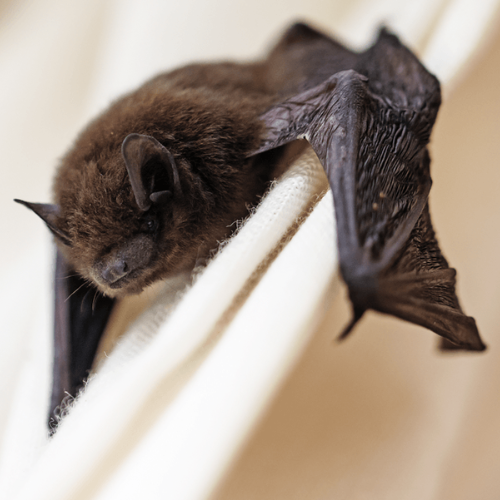The more than 40 species of bats that inhabit the United States are considered to be a keystone species, essential to the ecosystems they live in. Their pollination and seed-dispersing activities help seed and maintain plants that provide food and shelter for a wide range of other wildlife. Bats also help control populations of various flying insects, especially disease-spreading species like mosquitoes. Just one bat can consume up to 3,000 bugs in a single summer night.
Since the introduction of the Endangered Species Act of 1973 and the Fish and Wildlife Coordination Act of 1956, many sub-species of bats have been considered a protected species, following a considerable decline in numbers since the 1960s.
As the world’s only flying mammal, bats are as unique as they are invaluable to a healthy ecosystem. But that doesn’t mean you want a colony of these squeaky, winged rodents living in your home.
Bats looking for warm nesting areas in the winter months (and protected birthing grounds in the summer) find ideal habitats in the attics, chimneys, and walls of our homes, outbuildings, and commercial properties. Once ensconced in a place they feel safe, they immediately begin to reproduce and multiply at an exponential rate. Each newborn is ready to start having its own babies within a year, and each bat can live for decades, leading to a massive infestation in an incredibly short period of time.
Damage Caused by Bats
The good news is that bats aren’t wood-chewing pests, nor do they destroy building materials to build nests. The bad news is that bats poop a lot!
Bat urine and guano are both extremely odorous and highly acidic, coating and degrading attic eaves, support beams, and destroying any personal items stored in a range of their nesting areas and flight paths. The larger the colony grows, the more extensive and concentrated these droppings become, damaging insulation, wiring, walls, and sheetrock. Untreated guano damage has even been known to cause ceilings to collapse into rooms beneath nesting areas.
The stench of decomposing bats attracts carrion-eating insects and mammals, as well as being overwhelming to occupants. It’s also challenging (and expensive) to rid your house of.
Bat’s high-pitched squeaking, and the rustle of their leathery wings and scrabbling claws, can be very disturbing and uncomfortable for both people and pets alike.
Bats & Disease
Bat guano can be a severe health risk, especially for the very young, the elderly, and those with respiratory concerns. The fungus Histoplasma Capsulatum, which spreads by air once dung has dried and powdered, causes potentially fatal lung infections. Rabies is, of course, another risk. A fatal disease that can be spread from bats (and other mammals) to both people and pets, rabies is a virus that infects the central nervous system.
Due to these risks, as well as their federally protected status, it is vitally important NOT to attempt bat removal or guano clean-up yourself. There are even certain times of the year that bats cannot be removed from home or building unless they are in a living space. Hire a professional who has the training, disinfecting products, and safety equipment to dispose of guano without exposing themselves (or your family) to infections or airborne pathogens.
If you suspect that there are bats in your home or business, you should contact the wildlife removal experts at Veteran’s Pride Wildlife Control immediately. Again, do not attempt removal on your own. The health risks and legal repercussions are simply not worth the savings.

